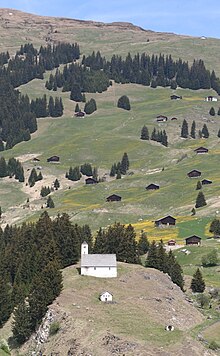Chapel of St. Eusebius
The St. Eusebius chapel is located in Breil / Brigels in the Surselva in the Swiss canton of Graubünden . It is dedicated to Eusebius von Vercelli .
history
The first written mention of the chapel comes from the year 1185. Since an old refuge castle is proven on the hill, Erwin Poeschel believes an early church castle from the early Middle Ages is possible. The four-storey tower with a previous church was probably built around 1100. Probably in the middle of the 14th century, the nave was expanded to its present-day dimensions using the south wall of the previous building. In the 17th century the chapel was widely visited as a pilgrimage church. A renovation took place in 1927, extensive restorations were carried out from 1973 to 1976.
Below the chapel is a small St. George's chapel with a rococo altar from 1784. It was first mentioned in 1643. The St. Peter and Paul Way Chapel below the George Chapel was renovated in 1939.
construction
The rectangular hall without choir is covered with a late Gothic wooden ceiling. The sanctuary is structurally not shown.
Furnishing
Paintings
The paintings come from four epochs. The oldest picture is the depiction of Christophorus on the southern outer wall from the middle of the 14th century by a Ticino or Lombard painter. The paintings on the east wall, which go around the corner to the south wall, were uncovered in 1928. They date from 1451 and are by the same artist who painted the pictures of the third stage of the Reformed Church in Waltensburg . They depict saints and apostles.
In the base zone of the south wall there is a mural from 1451 depicting the legend of the " encounter of the three living and the three dead ". From the right, a young man and two young women in courtly costume approach the three skeletons of the dead, the last of which can still be recognized as an archer and the penultimate as the Grim Reaper. The head and upper body of the dead person in front were badly damaged by the window that was later broken out. The texts on the banners can no longer be deciphered.
The large fresco of the Epiphany on the south wall is by Cristoforo and Nicolao da Seregno from around 1455.
The representation of the twelve saints on the north wall dates from the 18th century.
Altars
The large altar - without wings and predella - comes from the workshop of Ivo Strigel ; it is dated 1486. It shows Our Lady, on the right St. Antonius Abbot and Leonhard, on the left the Saints Wolfgang and Sebastian. The wings were presumably sold, as were the figures on the crown showing the Cadi cartridge , Martin, Placidus and Sigisbert. The painted reverse, rediscovered in September 1927, shows the Last Judgment with Mary and John as intercessors.
The winged altar in the rear part of the chapel from 1633 is from the workshop of Hans Jakob Greutter . It shows scenes from the life of the church patron St. Eusebius.
crucifix
The crucifix on the wall at the entrance is a presumably post-medieval replica of an original from the 13th century. The cross and painting are more recent.
gallery
Altar by Ivo Strigel
Fresco by Nicolao da Seregno
literature
- Erwin Poeschel : Art monuments of the canton of Graubünden. Volume IV, Birkhäuser Verlag, Basel 1943, p. 352.
- Ludmila Seifert, Leza Dosch: Art guide through Graubünden. Scheidegger & Spiess, Zurich 2008, p. 218.
- Dieter Matti: Old pictures - reinterpreted, church art in the pass country. Volume 3, Desertina, Chur 2012, ISBN 978-3-85637-370-2 , pp. 39-42.
Web links
- Pilgrimage Church of St. Sievi in the portal to Bündner Baukultur
Individual evidence
- ↑ Hans Georg Wehrens: The dance of death in the Alemannic language area. "I have to do it - and don't know what" . Schnell & Steiner, Regensburg 2012, ISBN 978-3-7954-2563-0 , p. 35.






